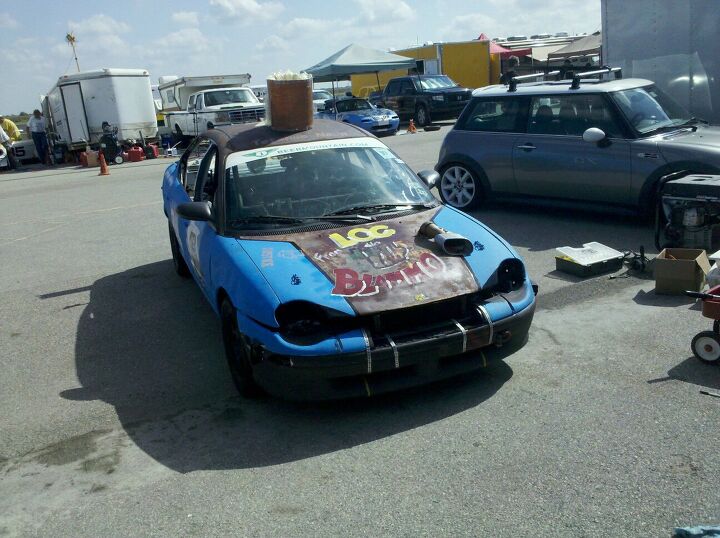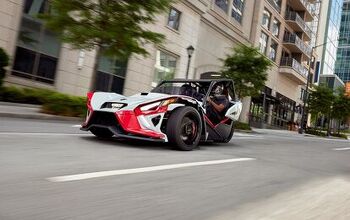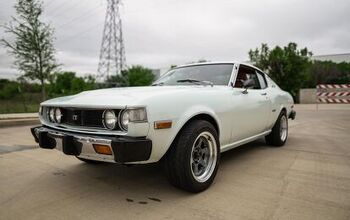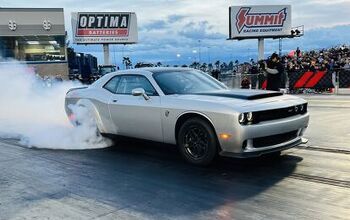Trackday Diaries: Dangerous Ticks, a Descent Into Madness.

Hear the rhyme of the Tetanus Neon
Well, that’s more the Iron Maiden version of “Rhyme Of The Ancient Mariner” than Coleridge’s, isn’t it? And yet, this is not a dissimilar tale. There’s plenty to tell about my stint as a driver for last weekend’s 24 Hours of LeMons — misfortune, dehydration of the aqueous and fuel varities, damage, failure, and, finally, escape.
Friday, 1:30AM — “You can’t write about me,” she says, “and, also, I’m not crazy like that one girl on your Facebook, (redacted).” Agreed on both counts, so that’s all we will say about this particular blue-eyed Tex-Mex beauty. I’d flown in to Houston’s Hobby Airport at five o’clock to meet some friends for dinner. In the early stages of the drinking, I’d gotten a text message from our own Murilee Martin, telling me that the Tetanus Neon team had been battling some sort of fueling issue all day in practice. “I’m sure they will figure it out,” he wrote.
Vaguely disquieted by this news, I’d allowed myself to have a couple of Ketel One doubles to wash away the worry. The party kept moving, from the Pappas Steakhouse through four more bars and finally landing at a “jazz club” where the house band played “Purple Rain” and “Rock With You.” After sobering up, I return to the steakhouse and convince the night janitor to find the keys for my rental in the valet stand.
Saturday, 9:00 AM — I arrive at the racetrack to meet my team and shoot the breeze with the other TTACers at the event. Mary, the young doctor who owns Tetanus Racing, is petite, forceful, and pale-skinned. She informs me that the fueling issue — a “bucking” which limits the Neon to 4500rpm — was intermittent yesterday and may not recur. In all other respects, the car is set to go. I’m scheduled to drive the fourth stint of this nine-hour day. With temperatures in the 105-degree range, it’s planned that those stints will be about an hour. I’m concerned about this. My experience racing LeMons has taught me that 150-minute stints are absolutely essential to winning, and 180-minute stints are better. We’ll have to see.
Saturday, 1:00PM — Our first driver, Jimmy, had experienced no problems with the car, but by the time Mary gets in, 4500rpm is the most it will rev without shaking and cutting out. Our lap times are perhaps twenty seconds slower than the car’s true potential. Still, we’re in the top half of the field from the simple expedient of continuing to proceed. All three of the other drivers come out of the Neon looking fairly dehydrated and dizzy; without power steering, and in this heat, it’s fairly tough to pull even a 75-minute drive.
We’re required to wear full drivers’ suits and keep our visors down while fueling the car, so I’m feeling a little beat just from being wrapped up in several layers of Nomex and running around pit lane. Mary, the third driver, reports that the rev ceiling has dropped to about 3800rpm and that the car can no longer sustain full throttle. We decide that the fuel pump needs to be swapped, but the nearest one can’t be in our hands until the end of the day. She’s also concerned about vibration from the CV joints. I agree to take it out for a while just to see what happens, but request that they completely fuel the Neon before I get in. Off we go!
Saturday, 2:30PM — I’ve been driving for an hour now. For most of my stint, the Neon hasn’t been able to accept more than half throttle or run more than slightly under 4000RPM. By using one-third throttle and no more than 3500RPM for a few laps, I’m able to build up a “push to pass” time where I can run as high as 4300RPM and full throttle opening for a few seconds.
Yes, I’m passing people. The driver talent pool at LeMons is always shallow — this is entry-level racing in $500 cars, not GP2 — but I’m surprised at how many people are utterly dismal at negotiating turns. If you are reading this and wondering, “Am I good enough to try LeMons,” and you successfully drove to work without killing a busload of kids, the answer is probably “Oh, yeah.” With about fifty horsepower on tap, using fifth gear where possible to get above seventy miles per hour but never seeing eighty, I’m passing cars almost as often as I’m being passed. Too often, however, they will simply blow by me on the next straight and then hold me up for two or three corners before I can short-brake them again. Still, we are climbing up the charts as cars break, retire, or take long driver changes.
Saturday, 3:00PM — I’m ninety minutes in and I am feeling pretty good, actually. Although I had failed to maintain my training regimen prior to arrival, I have a few advantages my co-drivers don’t have. To begin with, I’ve been racing cars without power steering for years, and I’m physically the largest person on the team, so the work is easiest for me. I’ve also consciously worked to keep my breathing and heart rate down during the stint, used my hand to direct fresh air to my face, and although I don’t use a Cool Shirt, I do have a hideously expensive OMP custom Grand-Am drivers’ suit that is much cooler than everyone else’s three-layer G-Force specials.
I find a true joy in driving the utterly powerless car as fast as it can go, holding the very last bit of corner speed, methodically unwinding out of every turn as soon as possible, drafting the faster cars and offering no courtesy to passing traffic. I decide to drive until the fuel runs out.
I’ve found a sparring partner on track: a Miata which drives away on the straights but falls back to my front bumper on the twisty back section of the track. This situation — a Miata having power, but lacking cornering, compared to a Neon — is so backwards from club racing it makes me laugh. A few times I manage to get side-by-side on the front straight, only to be drag-raced out by four car lengths. Oh well. Our duel lasts almost ninety minutes before I finally start to fuel-starve at 3:32 and call for a pit-in.
Saturday, 7:30PM — A full load of cold fuel fixes the bucking issue and the next two drivers have full use of the car. We’re up to seventh. Chris, the co-owner, sweats it out through a very difficult ninety-minute closing stint as I sit ready by pit lane to jump in at a moment’s notice. Amazingly, we are in seventh place; my lap times without power were very similar to the full-power laps turned later in the day, and running at that pace is apparently good enough.
Sunday, 2:30AM — (redacted)
Sunday, 6:30AM — I tumble into bed to sleep for two hours before the race.
Sunday, 6:45AM — There’s an emergency conference call for a production issue with my job back home. At one point I interrupt the proceedings to dry-heave for five minutes.
Sunday, 12:00PM — I arrive at the track to find the Tetanus Neon sitting in the paddock. The CV joints are making big noise and shaking like hell. On the plus side, the first driver had full power for his whole stint; on the minus side, the second driver didn’t. The new fuel pump, replaced by Mary and the crew while I was wandering drunk through downtown Houston, didn’t fix the issue. We are still in seventh but we are dropping fast.
Sunday, 12:30PM — Mary comes back in from a testing stint complaining about heavy vibration above pitlane pace. The left CV is thrashed. Worse yet, one of the lugs has snapped off the disc, with another one wobbling. We have no replacements. We are done.
Sunday, 3:00PM — I’m playing the bass line from “Tom Sawyer” through a massive Ampeg tube amp while notorious TTACer doctorv8 plays drums. It’s very cool in the house. Afterwards, we tour his collection of fabulous automobiles and discuss our Saturday nights. It seems very far from the heat and misery of LeMons, and it occurs to me that I could skip the race next time I come to Houston.
Sunday, 6:00PM — I’m stuffing my helmet bag into the overhead compartment when the woman seated next me says, in her Texas accent, “So… what do you do?”
“I’m… um, a race car driver,” I respond.
“What kind of cars?” she inquires, leaning over to display her fabulous endowment and smiling with megawatt teeth.
“Crappy ones,” I respond.
Thanks to: Tetanus Racing, Mary, Chris, Jim, Phil, Sajeev, the rest of the LeMons crew, and Sanjay. You see! I didn’t write about you!

More by Jack Baruth
Latest Car Reviews
Read moreLatest Product Reviews
Read moreRecent Comments
- Flashindapan I always thought these look nice. I was working at a Land Rover dealership at the time the LR3 came out and we were all impressed how much better it was then the Discovery in just about every measurable way.
- Bd2 If I were going to spend $ on a ticking time bomb, it wouldn't be for an LR4 (the least interesting of Land Rovers).
- Spectator Wild to me the US sent like $100B overseas for other peoples wars while we clammer over .1% of that money being used to promote EVs in our country.
- Spectator got a pic of that 27 inch screen? That sounds massive!
- MaintenanceCosts "And with ANY car, always budget for maintenance."The question is whether you have to budget a thousand bucks (or euro) a year, or a quarter of your income.



































Comments
Join the conversation
If you are reading this and wondering, “Am I good enough to try LeMons,” and you successfully drove to work without killing a busload of kids, the answer is probably “Oh, yeah.” -- Lines like these are why I read every Baruth article!
Lighten up, Francis, Great prose, Jack.